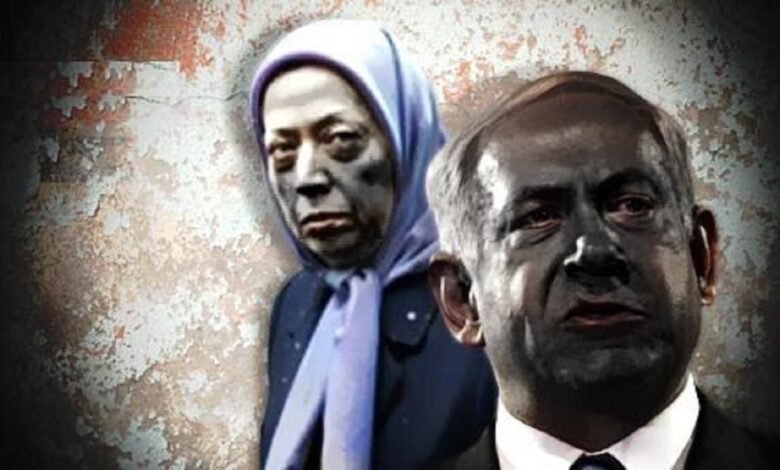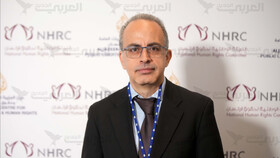A Narrative of the Cooperation between the MKO and Mossad
Association for Defending Victims of Terrorism - The Israelis first became interested in the MEK in the early 1980s. Israel viewed the Islamic Republic’s aid to Lebanon, which led to the emergence of Hezbollah and the larger Islamic resistance movement in that country, as a security nightmare and was keen to have credible security leverage against Iran.

In 1996, the Israelis changed their stance, concluding that investing in the Rajavi gang would not ultimately lead to bad results. The second meeting took place in May 1996 at a MEK safe house on the outskirts of Manchester. The safe house was controlled by “Ekram Damghanian,” who was at the time associated with the organization’s security wing.
According to ISNA, the Israelis first became interested in the MEK in the early 1980s. Israel viewed the Islamic Republic’s aid to Lebanon, which led to the emergence of Hezbollah and the larger Islamic resistance movement in that country, as a security nightmare and was keen to have credible security leverage against Iran. The Israeli intelligence services were at the same time in touch with royalist remnants and former SAVAK agents, although the effectiveness of these elements was not rated highly.
The first contact between the MEK and Israeli intelligence officers took place in December 1988. The main point of the meeting was Israel’s credible threat to bomb Iraqi nuclear facilities. The Israeli regime had previously made similar threats and carried them out in June 1981. The Iraqis therefore took the latter threats seriously. The Iraqi intelligence services effectively used the MEK as a point of contact with the Israelis.
Meeting on Gower Island
The meeting took place in a village in Kilvrough, on the Gower Peninsula in south Wales. The MEK representative was a four-man team from the organization’s security branch. They reported directly to Ebrahim Zakiri, the former head of MEK intelligence, and the MEK team was told by the intermediaries that they were to meet with middle-class officials in the Israeli Foreign Ministry, but the team members suspected that the meeting was a cover for Mossad.
The Israeli team was actually from the SHABAK or Shin Bet – Israel’s internal security and counterintelligence agency – and these were the only people that the Israeli intelligence service could send for such an operation in Britain at the time [1].
It should be noted, however, that the operation was ultimately controlled by Mossad. The arrangements for the meeting were coordinated by David Kimche, who was a senior official in the Israeli Foreign Ministry at the time. Kimche had previously been deputy director of Mossad, and it is possible that his position and role in the State Department in the mid-to-late 1980s were a cover for his real work.
The meeting was a success, as the Israelis never carried out their threat to bomb Iraq’s nuclear facilities. The MEK and the Israelis did not meet again for seven years. Several factors prevented the Israelis from responding to the requests of Rajavi’s agents.
The main one was the miscalculation that the Iraqi regime would fall prematurely in the 1991 Gulf War. The Israelis had estimated that the MEK would then be destroyed by the vengeful Shiite and Kurdish conquerors. Of course, the Israeli assessment ignored the reactionary nature of the Baath regime.
In 1996, the Israelis changed their position, concluding that investing in the Rajavi gang would not ultimately lead to bad results. The second meeting took place in May 1996 at a MEK safe house on the outskirts of Manchester. The safe house was controlled by Akram Damghanian, who was at the time associated with the organization’s security branch.
The head of the MEK security department, Ebrahim Zakiri, was in Manchester in early May 1996, ostensibly to review his own security team. But the reality of Zakiri’s unusual trip to that part of England was to meet with an Israeli intelligence delegation. This time, the team members were explicitly told that they would be meeting with Mossad. Again, the Israeli team consisted of four men in these negotiations. This time, the planner was Shabtai Shavit, a former Shin Bet director who was later recruited by Mossad to work with him. Interestingly, the Israeli intelligence service still uses the elderly Shavit in its news deceptions against Iran. [2]
The Foundation of the Sinister MEK-Mossad Connection
The foundation of the Mossad-MEK intelligence connection was laid at that infamous meeting. This connection continues to this day and largely revolves around Israel’s use of Rajavi’s mercenaries as sources of deceptive news. An interesting feature of the Israeli intelligence system is that, while it is one of the best at conventional intelligence work, it is extremely disorganized when it comes to psychological warfare and disinformation. Israel’s tendency to exaggerate and fabricate pseudo-information has discredited its traditional sources of disinformation. So relying on the MEK as a platform for disinformation in Iran gives the Israelis some reassurance that they are not relying on those traditional sources.
Soulless Carriers
The biggest blow to the MEK-Mossad disinformation was the so-called disclosure of the Natanz and Arak reactors in the summer of 2002. This disinformation was transmitted by a Mossad psychological warfare unit to a security team of the Rajavi terrorist sect in Europe. One of the tools the Israelis use to convey this type of information to their MEK operatives is by discreetly attaching encrypted data to portable computers and other computers.
The way these ultramodern “soulless carriers” work is very complex. The MEK travels to Europe and America to transport computers. The information enters the computers at the right time. The couriers are often unaware of the importance of the attachments unless they are from the organization’s security branch and have been “declared” of their mission. Of course, the Israelis do not rely on the MEK for classified information about Iran. The reason is simple; the MEK’s meager forces are not capable of providing this type of information. There is also no evidence that the Israelis have paid members of the sect.
From the perspective of the leaders of the Rajavi gang, this relationship is important because it enhances their standing among Western intelligence agencies. The Mossad has been heavily involved in propaganda on behalf of the MEK, the most important example of which is pressuring the Pentagon to keep the sect in the wastelands of Diyala province in Iraq.
The most important point to make about the Rajavi gang’s intelligence connection with Mossad is that it is, at best, a tactical collaboration between Israel and an unconventional sect whose ideology is a false amalgam of Marxism and Islam, and in which there can be no ideological affiliation or long-term goals. There is ample evidence in the history of intelligence that connections forged on the basis of tactical considerations are not only unsustainable but also unlikely to be of practical benefit.
Another feature of this intelligence connection is that it will ultimately be tied to the sophisticated intelligence of the “Great Game” between Iran and Israel. Israel needs some kind of leverage against Iran because the Islamic Republic is the main sponsor of the Islamic resistance in Lebanon – which is considered Israel’s greatest security threat. Given the complex strategic variables at play, it is difficult not to see that the relationship between Mossad and the MEK will end in great embarrassment for the Mossad and disaster for the sect.
Source:
- The Shin Bet agents were apparently investigating a security breach at the Israeli embassy in London at the time.
- R. Payne – Mossad; Israel’s Most Secret Service – London 1993 – p: 151 3.





